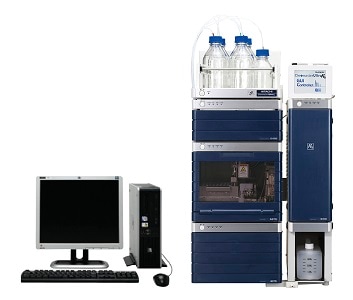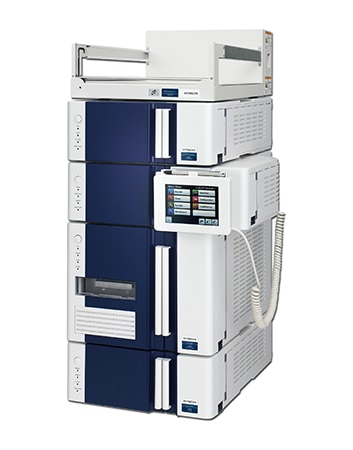High-Performance Liquid Chromatograph Primaide
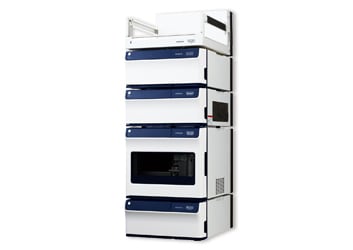
Affordable and robust HPLC system engineered for seamless integration and reliable analyses
High-Performance Liquid Chromatography (HPLC) is utilized in a wide range of fields, such as medicine, food production, chemistry, and environmental science, making the demand for HPLC systems higher among the various types of analytical equipment. The Hitachi Primaide HPLC is designed for long-term, stable operation, and features both high reliability and superior durability. It offers tremendous capability for everyday analysis.
Features
-
Simple operation for any HPLC user
Even in small to mid-scale facilities, individual operators see increasing opportunities to use multiple HPLC systems. Thanks to its simple design and front-access layout, maintenance of the Primaide is easy. Even a beginner at LC analysis can confidently operate the Primaide. -
Excellent basic performance
The demand for HPLC systems with higher precision, better reproducibility, and improved stability is increasing. The Primaide is built according to strict specifications to meet such stringent requirements. In addition, labs can apply the Primaide to an even wider range of applications by employing optional units, such as a sophisticated DAD (Diode Array Detector) and an autosampler cooling unit. -
Reliable durability
Hitachi HPLC systems have earned a reputation as highly durable machines, and the Primaide is no exception. Our strict production quality standards ensure both high performance and endurance. These standards are applied to all equipment from systems to accessories.
System Features
-
Optional units mounted inside provide clean appearance
All principal options, including a degasser, gradient unit, and sample cooling system can be mounted inside the main body. It is not necessary to make room for optional units. -
Front access layout for improved operation and maintenance
Every module is accessed and handled from the front. Since connections are arranged on the front, it is easy to replace columns and manipulate the flow system. For easier maintenance, the lamp and cell unit are also easily accessible. -
Leak sensors in all modules
Any leakage in the flow system is detected by leak sensors built into each module. After detection the system halts, ensuring improved safety and reliability. -
Complete control with system manager
A control panel is not necessary, as everything can be controlled via the system manager. By installing a UI- pad (optional), each module can be controlled separately. -
e-Line and USB
The e-Line is an advanced version of the existing D-Line. All modules are connected by an e-Line in a single chain, and all the communications are integrated. The use of digital signals improves the reliability of data transactions. The interface between the PC and equipment is via versatile USB. A wide range of PCs are supported, enabling flexible configuration. -
GLP function
A Hg lamp is installed in the detector, and wavelengths in the UV range can be calibrated using its emission line (254 nm) (installed in the Primaide 1410 UV / 1430 DAD). Each module stores various types of quality assurance information, for improved data reliability.
Example of Catechin Analysis
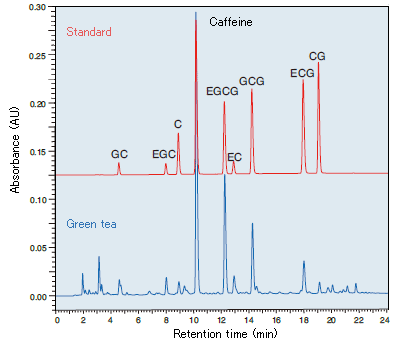
[Standard samples]
GC : (-)-Gallocatechin, EGC : (-)-Epigallocatechin, C : (-)-Catechin, EGCG : (-)-Epigallocatechingallate, EC : (-)-Epicatechin, GCG : (-)-Gallogatechingallate, CG : (-)-Catechingallate
Module lineup
1110 Pump
The Primaide 1110 Pump has been developed for reliable analysis and shares characteristics with Hitachi's existing HPLC pump models. Its consistently high level of performance provides users with strong support in everyday analysis.
-
Improvement of flow rate stability
For pulse compensation, a proprietary real-time feedback method has been developed for Hitachi’s pumps. Not only has the pulse been significantly reduced, but the Primaide 1110 Pump estimates pressure fluctuations and employs the optimal timing to set the plunger speed interval. -
Improvement of retention time reproducibility
For gradient analysis, injection by the Primaide 1210 Autosampler is synchronized with the movements of the pump. This ensures a highly reproducible retention time, and precise analysis.
| Peak No. | Component | Retention Time | |
|---|---|---|---|
| Average / min. | R.S.D. / % | ||
| 1 | Acetanilide | 2.032 | 0.076 |
| 2 | Acetophenone | 2.793 | 0.080 |
| 3 | Propiophenone | 3.581 | 0.096 |
| 4 | Butyrophenone | 4.495 | 0.102 |
| 5 | Benzophenone | 4.809 | 0.098 |
| 6 | Valerophenone | 5.639 | 0.083 |
| 7 | Hexanophenone | 6.975 | 0.082 |
| 8 | Heptanophenone | 8.413 | 0.068 |
| 9 | Octanophenone | 9.882 | 0.078 |
| Condition | |
|---|---|
| Column | HITACHI LaChrom C18 (5 µm) 4.6 mm I.D.×150 mm L. |
| Mobile phase | A : CH3OH B : H2O |
| Gradient program | 0 - 11 min A 65 → 100% |
| Column Temperature | 40°C |
| Flow rate | 1.0 mL/min |
| Detection | UV 265 nm |
| Injection vol. | 10 µL (100 g/mL each.) |
1210 Autosampler
The Primaide 1210 Autosampler incorporates direct injection, allowing the automation of consecutive analyses without wasting precious sample.
-
Direct injection of small-quantity samples and quicker analysis
In the direct injection method, the sampling needle becomes part of the flow channel so that the sample in the needle flows into the channel with zero waste. This is a great advantage in the analysis of valuable small-quantity samples. In addition, since the injection method is simpler than using a sampling loop, the injection cycle is shortened by half. This method accelerates throughput and improves efficiency in the analysis of many samples. -
Improved reproducibility results in high-precision analysis
The syringe for sample measurement is driven by a high-performance motor. The drive improves the reproducibility of injection. Furthermore, peak retention times are also more repeatable due to synchronization of injection with the pump motion, achieving higher analytical reliability.
Injection Volume Reproducibility
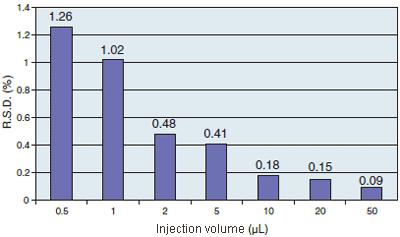
| Condition | |
|---|---|
| Sample | Methyl paraben |
| Mobile phase | CH3OH : H2O = 60 : 40 |
| Flow rate | 1.0 mL/min |
| Detection | UV 265 nm |
1310 Column Oven
The Primaide 1310 Column Oven also functions as a cooler. The preheating function obtains better performance from columns, achieving sharper peak shapes.
-
More resolved peaks with optimized heating
Pre-heating with an efficient block heater improves the symmetry and sharpness of peaks, eliminating the influence of ambient temperature changes. The column installation space, which features an air circulation system, permits the easy mounting and detaching of columns. -
Cooling function is included as standard
The oven can regulate the temperature from 5°C to 65°C.
1410 UV Detector
The optics of the Primaide 1410 UV detector allows data collection with lower noise and drift. The lamp and flow cell are situated in a front-access layout and are easily replaceable.
-
Low noise for high-sensitivity detection
The Primaide 1410 UV detector achieves a noise level of no more than 0.6 × 10 -5 AU, greatly enhancing trace component analysis. -
High response and low noise for rapid analysis
Low-noise measurements in 0.05 seconds.
High-sensitivity detection rapidly yielding sharp and accurate peaks. -
Stable, without influence from ambient temperature changes
Since local environments may vary considerably, the optics of the UV detector is well designed to avoid the effects of daily and seasonal temperature changes, ensuring stable and reproducible results. -
Wavelength measurement in the UV region with a built-in Hg lamp
Use the 254-nm emission line of the mounted Hg lamp to test the accuracy of wavelength measurement in the UV region, which is the most utilized region in liquid chromatography. This test is conducted using 3 wavelengths from the Hg and D2 lamps, enabling highly reliable analyses across a broad wavelength range.
1430 Diode Array Detector
The Primaide 1430 Diode Array Detector is as sensitive as a UV detector. The DAD system has many functions, including spectrum collection, chromatography using multiple wavelengths, a peak purity test, a spectral library, and more.
-
High sensitivity
Novel optics and improved software reduce noise considerably (0.5 × 10-5 AU or less). The reputation, "DADs are less sensitive," is now obsolete. -
Minimizing the influence of temperature changes in the measurement cell
The light source is stabilized via a large lamp housing. The spectrometer and housing are separated and thermally insulated. By cooling the lamp housing separately, the influence of ambient temperature is minimized. The new design incorporates temperature sensors as well as an associated variable rotation speed cooling fan, which largely eliminate temperature changes inside the instrument. This reduces noise and enhances stability, allowing for stable analysis day after day. -
High resolution and accurate spectra
High wavelength resolution (0.78 nm/data point) is achieved with an array of 1,024 photo diodes. Uniform resolution is maintained throughout a wide range of wavelengths from the UV to VIS, thanks to the diffraction optics, which features a grating. -
Digital noise reduction in rapid analysis
Data with a low level of noise are obtained in a very short sampling period (0.05 seconds). Noise-free, sharp peaks are obtained during rapid analysis. -
Automatic wavelength calibration
A built-in Hg lamp is utilized in the automatic wavelength accuracy test for the commonly-used UV region.
Three-Dimentional Chromatogram
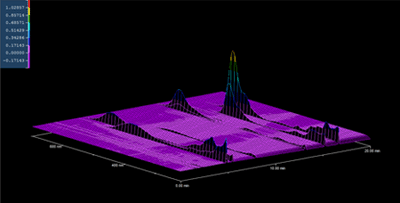
Organizer
Organizer capable of accommodating various solvent bottles
The organizer can accept the simultaneous mounting of the following solvent bottles.
| 1 | 3.785 L (U.S. gallon bottle) × 2 + 500 mL × 2 |
|---|---|
| 2 | 1.0 L × 5 |
Organizer also is a power supply module
The organizer, which is also a power supply module, provides power to one pump, one autosampler, one detector (one UV detector, or one Diode array detector), and one interface control board.
Example of Applications
Here are some latest applications measured by the Primaide.
Catechins are important antioxidant components found in tea. Due to their antioxidant properties and wide range of efficacy, research of catechins has been receiving an increasing amount of attention. The catechin profile in tea has been found to differ depending on the method of tea preparation. In addition, the catechins in tea form thermal isomers during the sterilization process of commercially available bottled tea drinks. The concentration of thermal isomers reaches significant levels, and, as such, the physiological function of these isomers is also of interest. The following describes examples of analysis of catechins and caffeine in tea.
Organic acids are known as ingredients that determine the taste and flavor of foods. In addition to the food sector, many other areas such as pharmaceutical and chemical industries, environmental analysis, and biotechnology, analyze organic acids.
Analysis methods of organic acids include UV detection (detection of absorption of carboxyl groups), electrical conductivity detection (detection of ionic compounds), a method using pH indicators (visible absorption detection of pH changes caused by acidic components) and a post-column derivatization method for high selectivity of detection. An appropriate method must be selected based on analysis samples and purposes.
The following describes examples of analysis of organic acids using a portable UV detection system and the reversed-phase column, "LaChrom C18-AQ".
Paraben is a generic term for p-hydroxybenzoate esters. Due to their low toxicity in the human body, as well as antiseptic and mold proofing effects, parabens are used as preservatives in medicines, cosmetics, and foods. Phenoxyethanol is another component used as a germicide and antiseptic in cosmetics. It is a naturally-occurring compound that is found in substances such as green tea.
Phenoxyethanol is often used in combination with parabens in cosmetics to reduce the added paraben content.
In this presentation, we will introduce and examine the simultaneous analysis of phenoxyethanol and parabens.
Glycoside is a collective term used for the compound formed by glycosidic bonding between a sugar and a compound other than sugar (non-sugar component: aglycone).
Glycosides are mainly O-glycosides, sugar derivatives with various physiological activities that are widely distributed in plants.
Glycosides are also widely known as components of crude drugs. Presented here is the analysis of the glycosides swertiamarin, puerarin, paeoniflorin, sennoside, and glycyrrhizinic acid using HPLC with diode array detector (DAD).
Multiple peaks of various components are detected in the analysis of a crude drug. By using DAD, the UV absorption spectra of the target component and the Standard Sample can be compared and confirmed and therefore, more accurate quantitative analysis is possible.
Vitamins are essential nutrients, and are classified into water-soluble vitamins and fat soluble vitamins. We have simultaneously analyzed 9 water-soluble vitamin components by separation through a reverse phase column and diode array detector (DAD). By using DAD, detected peaks can be identified from absorption spectra. Thus, food and other samples containing many contaminants can be analyzed effectively.
Please take care to note that since vitamin C and erythorbic acid are unstable, they are easily decomposed during sample preparation or with the passage of time, and that it is difficult to obtain linearity and reproducibility. Therefore, these analysis conditions are suitable for qualitative analysis. For quantitative analysis, the use of an individual test method for each vitamin is recommended.
Aspartame is an artificial sweetener that is 100 to 200 times sweeter than sucrose. It is a dipeptide formed by peptide bonding of methyl ester of phenylalanine with aspartic acid. Aspartame is mainly added to low calorie and non-caloric drinks and foods. It is also sometimes used with other sweeteners such as sugar and sorbitol.
Examples of analyses for aspartame in (1) carbonated drink and (2) apple cider vinegar drink are introduced here.
Food dyes, when added to food or drinks, play an important role of enhancing palatability. Food dyes are largely divided into natural dyes and synthetic dyes. An analysis example for six synthetic dyes is introduced here.
Six dyes analyzed here have maximum UV absorption at different wavelengths and therefore, DAD (diode array detector) was used to analyze them simultaneously. By using DAD, a chromatogram can be extracted at the optimal wavelength for each dye.
As a spectrum of a standard sample can be compared with that of a target component for confirmation, more accurate quantitative analysis is possible.
NOTE:
These data are an example of measurement; the individual values cannot be guaranteed.
The system is for research use only, and is not intended for any animal or human therapeutic or diagnostic use.

